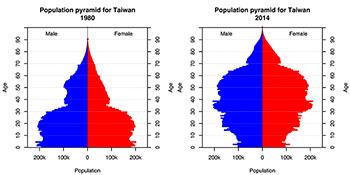1 Demographic change
Demographic change can be caused by the increasing mobility of people internationally; for example, war and famine as drivers of mass movement from and within Syria, Iraq, Sudan etc., or economic migration as people move to find more stable and better paid employment to support their families, often leaving behind a skill shortage. It can also be caused by changes as birth rates rise or fall, either as a result of policy, standards of living change or conflict. Similarly, changes in lifespan can rise or fall due to improvements in wealth and healthcare or destabilisation of governments and associated conflict and infrastructure decline. In recent times, the world has also been affected by constraints in travel as the COVID-19 pandemic affected different countries at different times and with different national responses. This is likely to change, in ways yet unknown, patterns of immigration and emigration. Whatever the reasons, some nations’ populations are growing while others are decreasing. This is associated with changes to the spread of age groups in a country at any one time and the proportion of dependents to those of employable age. Population pyramids represent demographic spread and can be used to show how these dynamics can change over just a few decades, as in the case of Taiwan, shown in Figure 2.
Migration, currently an issue globally, is changing national demographic structures and driving political change. Many current events seem to have their basis in issues of migration; for example, Brexit in the UK, President Trump’s plans to build a wall along the USA’s border with Mexico and the rise in support for Marine Le Pen in France and other far right leaders in Europe.
Activity 1 Migration and demographic change
Spend some time exploring the International Migration Statistics [Tip: hold Ctrl and click a link to open it in a new tab. (Hide tip)] published by the Migration Policy Institute. Use the data available on that website to establish whether people are moving to your home country or moving away from it.
Think about:
- In what ways is your country affected by migration?
- Can you identify three reasons why the migration your country is experiencing may cause issues for your education system?
Discussion
Some examples of how migration can affect education systems:
- Having more people means there are more children to educate, and therefore a greater need for school places and teachers.
- People leaving a country often means that the best educated leave, so there may be less income from taxes and fewer teachers for the next generation.
Please note: we may wish to reuse your forum contributions, anonymously, in future sessions of this course. If you wish to opt out of this, email WELS-ECYS-Masters@open.ac.uk .
You will now consider the impact conflict and migration can have on children who would otherwise be in secondary education.
Activity 2 The effects of demographic change on students’ education
- Read the article World Report 2017 – The Lost Years (Khawaja et al., 2017). This is a long article and to manage your workload it is recommended that, after reading the introduction, you select one section which interests you the most (using the left hand tool bar), and the conclusion entitled ‘Ways forward’.
- Find and post to the course forum a hyperlink to a news article that relates to your own country’s experiences of demographic change, including that caused by migration (emigration or immigration). Posting this can stimulate thinking about how this is affecting your education system. The article might relate to the reasons for the movement of people, identification of particular groups of people affected, and/or how society is responding. It might relate to changes in the balance of age groups. Add a brief reflection on how your country’s education system is (or should be) responding to the challenges of demographic change. Indicate which country you are reflecting upon in your post.
- Read two or three other posts and consider how education needs to adapt to the needs of all those affected by migration or demographic change. You might find it helpful to reflect on the three approaches to education introduced in Week 2 to reflect on these issues from different perspectives.
Remember that you need to add at least 3 posts to the forum in order to gain your badge.
Please note: we may wish to reuse your forum contributions, anonymously, in future sessions of this course. If you wish to opt out of this, email WELS-ECYS-Masters@open.ac.uk .

